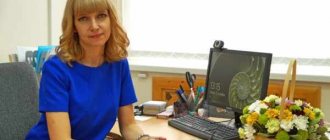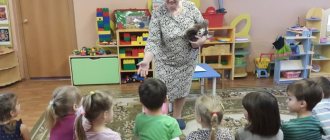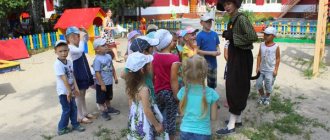GCD Self-Analysis
Tatiana Zvyagina
GCD Self-Analysis
Introspection.
GCD senior group “The Magic World of Butterflies”
Integration of educational areas: social-communicative, cognitive, physical development, speech development, artistic and aesthetic.
Educational field "Social and communicative development"
:
• encourage initiative and curiosity in order to consolidate acquired knowledge;
• develop the ability to answer the question posed with a complete answer;
• cultivate a caring attitude towards the environment;
• improve the ability to listen to a friend’s answer and not interrupt;
Educational field "Speech development"
:
• Activate children's vocabulary;
Educational field "Physical development"
:
• develop a sense of rhythm and tact (rhythmoplasty)
;
• develop fine motor skills of hands
Educational field "Cognitive development"
:
• To form children’s understanding of the life of a butterfly, its structure, vital activity, life cycles and species.
• consolidate active vocabulary on the topic;
• develop cognitive interest in nature
• develop attention and logical thinking.
Educational field "Artistic and aesthetic development"
:
• develop the ability independently convey images of objects using visual means and various materials: plasticine, beads, rope, felt, sequins, rhinestones, paper, stacks;
• develop creative abilities, a sense of beauty, aesthetic perception
Tasks:
Educational:
To form children’s understanding of the life of a butterfly, its structure, vital activity, life cycles and species; develop the ability to independently , creatively depict the “life cycle of a butterfly”
using artistic design; expand and enrich children's vocabulary.
Educational:
To develop cognitive interest in nature and cognitive abilities of children; develop imagination, sense of composition (plot lines)
creativity, communication skills.
Educational:
To cultivate responsiveness, the ability to demonstrate creativity and activity; cultivate curiosity, artistic taste and interest. creativity.
Direct educational activities, further NOD, were carried out with a group of children of senior preschool age 5-6 years old. The lesson consisted of three parts (stages)
interconnected, during which children gradually performed various actions.
This structure is completely justified, since each part (stage)
of the lesson is aimed at solving certain problems and offers a choice of methods and techniques. Goals and objectives correspond to the targets of the Federal State Educational Standard for Education.
Part 1 Organizational.
Motivation of children in upcoming activities. At this stage of the GCD, the method of game motivation was applied: the arrival of the “harbinger of spring”
.
Through breathing exercises, I got to know the children as a psychologically unloading, relaxing moment. Children were invited to go on a virtual journey to the "Magic World of Butterflies"
. GCD was a specially organized activity for children. They watched a presentation during which they became acquainted with the types of butterflies, their characteristics and life cycle.
Part 2 Was conducted by Ri
to a waltz from the ballet coppelia by composer Leo Delibes. In order to prevent fatigue, prevent poor posture, prevent the musculoskeletal system, respiratory system, psycho-emotional release.
Part 3 Productive activity It presented work on artistic design. The children were asked to make a butterfly cycle, gradually depicting the plot on a green leaf base. Using plasticine, beads, felt blanks, sequins. We reinforced the techniques of rolling a ball and rolling out a cylinder (giving it an oval shape)
.
The technique of attaching beads and superimposing a smaller figure in size onto a larger one. Create a beautiful composition “Birth of a Butterfly”
A surprise moment was used - a gift of green ribbons (bracelets)
. As a symbol of children's caring attitude towards nature. And a lapbook as a summary of the lesson.
She consolidated the positive results of the Reflection session with verbal encouragement.
To implement each task, I selected techniques that helped solve them. When working with children, I used conversation, asking children questions to test their intelligence and logical thinking. All this contributes to the effectiveness of GCD in children’s mental, creative activity and speech development. The material for ECD was selected at a level accessible to children, corresponded to their psychological characteristics and was rational for achieving goals and objectives. The children were active, attentive, and felt comfortable. All this confirms the results of our activities.
All elements of GCD are logically united by a common theme. The activities of NOD are characterized as joint and individual.
I used the following forms of work: frontal, individual, group.
The following methods:
— Verbal (conversation, riddles, questions are given from the point of view of the development of mental activity, the development of dialogical speech, poems, encouragement);
— Visual demonstration (multimedia installation - presentation on the topic “The magical world of the butterfly, pictures with the types and characteristic features of butterflies).
— Game (the arrival of the fairy-tale hero “the messenger of spring”
, breathing exercises, asking riddles, dancing using ri means
, green ribbons with flowers - as a symbol of respect for nature, an album (lapbook)
as the result of the lesson).
— Practical (artistic design)
The game form of the lesson, the novelty of artistic design. Contributed to the successful solution of assigned tasks, the formation of certain skills in artistic design. And what is especially important is the development of creative abilities. Children's positive emotions were enhanced by the use of audio recordings.
Working together with children, I tried to establish stable contact with them, thus creating a creative workshop where everyone is engaged in one thing - art.
I believe that the form of organization of children’s educational activities I chose was quite effective and dynamic. I tried to comply with the norms of pedagogical ethics and tact. I believe that the tasks assigned to the NOD were completed.
GCD has achieved its goal!
A project of self-analysis of educational activities directly.
A project of self-analysis of educational activities directly.
Full name of the teacher
: KeV teacher
OU
: Municipal budgetary preschool educational institution “…. »
Program:
“From birth to school” under. ed. N.E. Veraksa, M.A. Vasilyeva, T.S. Komarova.
Group, age of children
: junior group
Lesson topic:
"Winter Journey".
At the lesson “Winter Journey” the following goal was set: Continue to expand the active vocabulary of children on the topic of winter.
Tasks:
Educational:
Continue to learn to distinguish and name geometric shapes: circle, triangle.
Develop the ability to answer questions, cultivate interest in living nature.
Develop the ability to answer questions.
Educational:
Develop visual perception, attention, thinking, observation.
Develop communication and speech skills.
Develop children's fine motor skills.
Educational:
Encourage children to want to participate in a conversation (conversation) with the teacher.
Foster a sense of responsibility, organization, active attention, and develop the ability to work in pairs.
Integration of educational areas
: Cognitive development + physical development + speech development + artistic and aesthetic development
Types of children's activities:
cognitive activity, productive activity, communicative activity, gaming activity.
Preliminary work:
observing during walks (drifts), looking at paintings, illustrations with images of snowmen, reading books, systematizing knowledge about the circle and triangle.
GCD structure
Direct educational activities (hereinafter referred to as GED)
This direct educational activity (DEA) was carried out with 8 children of primary preschool age.
Taking into account age characteristics, the children answered the teacher’s questions, maintained a conversation, looked at the picture of a snowman with interest, and performed activities and exercises. The children were quite active and felt comfortable.
The following working methods were used at the GCD:
Visual and demonstrative method: showing objects, showing a method of action, showing a picture, using ICT.
Verbal methods: conversation, questions, explanation, surprise moment.
Practical methods: exercise (ICT), construction, dynamic pause.
Game method
Problematic - search engine
Methods include a system of techniques that are combined to solve learning problems. Techniques (explanations, instructions, demonstration, commands, play techniques, artistic expression, encouragement, helping the child, analysis, introductory conversation) are aimed at optimizing the individual development of each child.
The educational activity itself consisted of three interconnected stages, during which children gradually performed various actions. This structure is completely justified, since each part of direct educational activity is aimed at solving certain problems and offers a choice of methods and techniques
Introductory part
organization of children, motivation for upcoming activities. At the organizational stage of the GCD, a surprise moment was used - the appearance of a snowflake.
Main part
ECD was a specially organized and independent activity of children aimed at solving assigned tasks and solving problem situations. (find a pair for a snowflake, a nose for a snowman). The main part: the mental and practical activity of children, tasks were included on mental development and perception of the surrounding world, systematization of existing knowledge, and consolidation of speech skills. To relieve general fatigue, a dynamic pause was carried out. Individual work was manifested in helping those who found it difficult to answer.
In the final part
GCD
To implement each task, I selected techniques that helped solve them. The techniques were based on game situations in which I tried to consolidate the children’s knowledge about geometric shapes and the season - winter.
When working with children, I used conversation, questions to children on attentiveness, intelligence and logical thinking - all this contributed to the effectiveness of educational activities, mental activity and cognitive development of children.
The material for the educational activities was selected at a level accessible to children, corresponded to their psychological characteristics and was rational for solving the set goals and objectives. They were active, attentive, and felt comfortable.
All elements of GCD are logically united by a common theme.
This structure of the lesson is completely justified. Since each part of the lesson is aimed at solving certain pedagogical problems and offers a choice of adequate methods and techniques. The content of the lesson corresponded to the assigned tasks.
Activities at GCD are characterized as joint and individual.
At NOD I used the following forms of work: individual, group.
I believe that the form of organizing the direct educational activities of children that I chose was quite effective and dynamic. I tried to comply with the norms of pedagogical ethics and tact. I believe that the tasks set in direct educational activities were completed! GCD has achieved its goal!
Self-analysis of NNOD in the senior group on cognitive development “Houseplants”
Self-analysis of NNOD in the senior group on cognitive development “Houseplants”
Integration of educational areas: cognitive,
social-communicative, speech.
Goal: to consolidate children’s knowledge about indoor plants, maintenance conditions, and proper care.
Tasks:
— Fix the names of indoor plants.
— Teach children to distinguish plants by appearance.
— Improve plant care skills.
- Activate children's vocabulary.
— Foster a love for living nature.
The purpose and objectives of the GCD correspond to the program requirements of the age group. The duration of the GCD is 25 minutes. Introductory part – 3 min. ; main part – 18 min. ; final part – 4 min.
The duration of the GCD corresponded to the requirements of the program.
In the introductory part of the GCD, to create interest in the topic, I used a technique - a surprise moment (letter).
In the main part, the NOD used techniques - conversation, showing methods of action, using samples, explanation.
All parts of the GCD were interconnected and subordinated to a given topic, purpose and objectives of the GCD. A properly organized change of activities made it possible to prevent fatigue and oversaturation in children.
Methods used:
— verbal (for questions to children, encouragement);
— visual (filming);
- practical (in completing the task);
- control method (in the analysis of completed work - approval and praise).
All teaching methods and techniques corresponded to the program content and age characteristics of the children.
The speech was expressive, calm, and reasonable.
Used health-saving components: changing children's positions; to keep children interested.
I believe that the form of organization of children's educational activities I chose was quite effective. Throughout the entire educational activity, UUD (universal educational activities, in accordance with the requirements of the Federal State Educational Standard) were formed.
Analyzing the activities of children in educational activities, I would like to note that they showed cognitive activity in environmental education, used competent knowledge and skills in cognition, in work activities in nature. They were interested, attentive, organized. She involved indecisive and shy children in answering questions and helped with verbal instructions in their work. The children sought to independently analyze their work and the work of their comrades.
Analyzing the GCD, we can say that the set goals and objectives were successfully completed.
The children worked at their own pace and completed the task according to their individual capabilities.
The children pleased me that the kindness of a child’s soul, their curiosity, interest in the environment was felt throughout the entire NOD.
Get text




